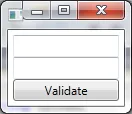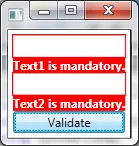这是根据Josh Smith的文章“
绑定到(Validation.Errors)[0]而不创建调试输出”改编的解决方案。
诀窍是定义一个
DataTemplate来呈现
ValidationError对象,然后使用
ContentPresenter来显示错误消息。如果没有错误,则不会显示ContentPresenter。
下面,我分享了我创建的示例应用程序的代码。


这里是XAML:
<Window x:Class="WpfApplication1.MainWindow"
xmlns="http://schemas.microsoft.com/winfx/2006/xaml/presentation"
xmlns:x="http://schemas.microsoft.com/winfx/2006/xaml"
SizeToContent="WidthAndHeight"
Title="MainWindow">
<StackPanel Margin="5">
<StackPanel.Resources>
<DataTemplate DataType="{x:Type ValidationError}">
<TextBlock Text="{Binding ErrorContent}" Foreground="White" Background="Red" VerticalAlignment="Center" FontWeight="Bold"/>
</DataTemplate>
</StackPanel.Resources>
<TextBox Name="TextBox1" Text="{Binding Text1, UpdateSourceTrigger=PropertyChanged, ValidatesOnDataErrors=True}"/>
<ContentPresenter Content="{Binding ElementName= TextBox1, Path=(Validation.Errors).CurrentItem}" HorizontalAlignment="Left"/>
<TextBox Name="TextBox2" Text="{Binding Text2, UpdateSourceTrigger=PropertyChanged, ValidatesOnDataErrors=True}"/>
<ContentPresenter Content="{Binding ElementName= TextBox2, Path=(Validation.Errors).CurrentItem}" HorizontalAlignment="Left"/>
<Button Content="Validate" Click="Button_Click"/>
</StackPanel>
</Window>
代码后文件:
namespace WpfApplication1
{
public partial class MainWindow : Window
{
private ViewModel _ViewModel = null;
public MainWindow()
{
InitializeComponent();
_ViewModel = new ViewModel();
DataContext = _ViewModel;
}
private void Button_Click(object sender, RoutedEventArgs e)
{
_ViewModel.Validate = true;
_ViewModel.OnPropertyChanged("Text1");
_ViewModel.OnPropertyChanged("Text2");
}
}
}
视图模型:
using System;
using System.Collections.Generic;
using System.Linq;
using System.Text;
using System.ComponentModel;
namespace WpfApplication1
{
public class ViewModel : INotifyPropertyChanged, IDataErrorInfo
{
private string _Text1;
public string Text1
{
get { return _Text1; }
set
{
_Text1 = value;
OnPropertyChanged("Text1");
}
}
private string _Text2;
public string Text2
{
get { return _Text2; }
set
{
_Text2 = value;
OnPropertyChanged("Text2");
}
}
public bool Validate { get; set; }
#region INotifyPropertyChanged Implemenation
public event PropertyChangedEventHandler PropertyChanged;
public void OnPropertyChanged(string propertyName)
{
if (PropertyChanged != null)
PropertyChanged(this, new PropertyChangedEventArgs(propertyName));
}
#endregion
#region IDataErrorInfo Implementation
public string Error
{
get { return null; }
}
public string this[string columnName]
{
get
{
string errorMessage = string.Empty;
if (Validate)
{
switch (columnName)
{
case "Text1":
if (Text1 == null)
errorMessage = "Text1 is mandatory.";
else if (Text1.Trim() == string.Empty)
errorMessage = "Text1 is not valid.";
break;
case "Text2":
if (Text2 == null)
errorMessage = "Text2 is mandatory.";
else if (Text2.Trim() == string.Empty)
errorMessage = "Text2 is not valid.";
break;
}
}
return errorMessage;
}
}
#endregion
}
}

